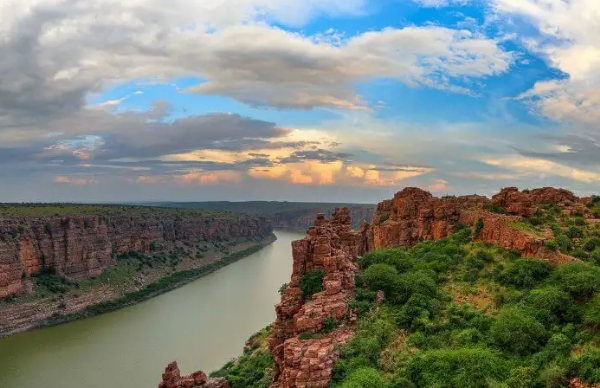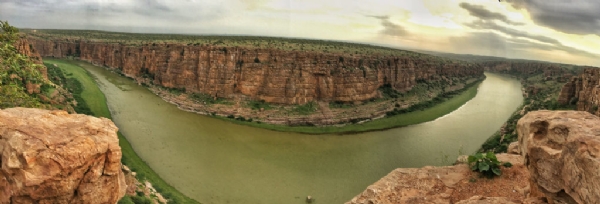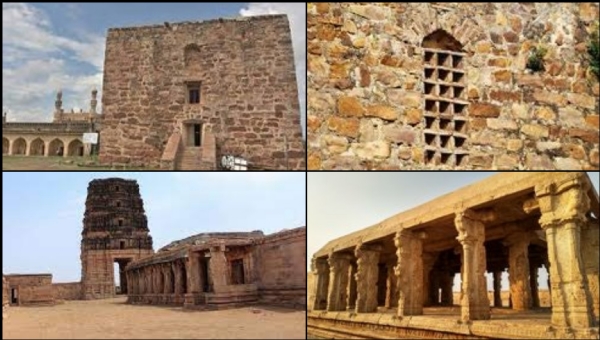Gandikota fort, the Grand Canyon of India
While the Gandikota is more famous nowadays due to that gorge through which the Penna flows, the fort here has a long, glorious history.
Total Views |
We all know of the magnificence in the form of the Grand Canyon in Arizona. But how many of us know of the gorge of the Gandikota fort, right here in India, just as magnificent, if not more?

The Pemmasani Nayakas were regarded as the sword arm of the Vijayanagara Army, known for their fighting ability. It gets its name due to the gorge formed between the Erramala hills range, where the Penna river flows through a narrow gap of just 300 ft, creating a breathe taking site.

Ramalinga Nayaka played a major role in Sri Krishnadeva Raya's victories over the Bahmani Sultans of Golkonda, Bijapur, as well as the Battle of Raichur - where he led from the front in one of the greatest triumphs ever for the Vijayanagara Empire.
The fort has two temples dedicated to Madhavaraya and Ranganatha, though the latter one is more in ruins now. The former one was built during reign of Sri Krishna Deva Raya. However, the main deity was shifted to Mydukuru when the fort was captured by the Golkonda sultans.
 Some of the other attractions at Gandikota fort include the House of Drums, a Charminar like structure, the prison. And a lake known as Erra Koneru, so called as warriors used to wash their blood-stained swords here, turning it red.
Some of the other attractions at Gandikota fort include the House of Drums, a Charminar like structure, the prison. And a lake known as Erra Koneru, so called as warriors used to wash their blood-stained swords here, turning it red.

The hidden gorge of Gandikota is located in Andhra Pradesh and is known as the Grand Canyon of India. Firstly, lets know what a gorge is. A gorge is a valley which is formed by a source of flowing water between tall, steep rocks.
The unique Gandikota Fort is situated on the gorge overlooking the Penna River, 15 km from Jammalamadugu in Kadapa district, Andhra Pradesh. It was is constructed back in the 1123 AD, by a Kalyani Chalukya ruler, Someswara I. This fort is known as India's very own Grand Canyon. While the Gandikota is more famous nowadays due to that gorge through which the Penna flows, the fort here has a long, glorious history.
The Pemmasani Nayakas were regarded as the sword arm of the Vijayanagara Army, known for their fighting ability. It gets its name due to the gorge formed between the Erramala hills range, where the Penna river flows through a narrow gap of just 300 ft, creating a breathe taking site.

While the canyon itself is splendid in its own way, the history of the fort is just as fascinating. The name of the fort itself has become a synonym for bravery and courage, much like that of Bobilli, Kondaveedu. The Pemmasani Nayak kingdom was founded by Pemmasani Timma Nayaka, when Sri Krishna Deva Raya, gave him the control of Tadipatri province circa 1509.
History | The current fort was built by Pemmasani Ramalinga Nayaka, the commander of the Vijayanagara Army, under Sri Krishnadeva Raya, son of Pemmasani Timmanayudu II, renowned as a great warrior.
Ramalinga Nayaka played a major role in Sri Krishnadeva Raya's victories over the Bahmani Sultans of Golkonda, Bijapur, as well as the Battle of Raichur - where he led from the front in one of the greatest triumphs ever for the Vijayanagara Empire.
Also Read | Udayagiri Caves, the arcane caves in Madhya Pradesh
He made Gandikota as the capital, and ruled over a large territory that included Tadipatri, Gutti, Kondaveedu and stretched all the way up to Kondapalli. The Pemmasanis would later play a major role in the Aravidu dynasty seizing power post Sri Krishna Deva Raya. However, with Pemmasani Timma Nayaka the last ruler of Gandikota losing to Mir Jumla in 1652 AD, the fort came under the control of the Golkonda Qutub Shahis, it later came under the British rule.
The fort has two temples dedicated to Madhavaraya and Ranganatha, though the latter one is more in ruins now. The former one was built during reign of Sri Krishna Deva Raya. However, the main deity was shifted to Mydukuru when the fort was captured by the Golkonda sultans.

The Madhavaraya Temple is known for its ornate mandapa, and a five storey Gopuram, carved with sculptures and a wide courtyard. The fort also has a large granary with a vaulted roof used for storing food grains, an ammunition magazine now mostly in ruins.
Also Read | Bhimkund, the mystical bottomless water lagoon in MP
There is also the Jamia Masjid within the fort premises, built during the reign of the Golkonda Sultans. The magnificent gorge, the canyon, the Penna river, the fort with its rich history, all make Gandikota one of those places to be visited in your lifetime. There is also a Haritha Tourism resort there.


